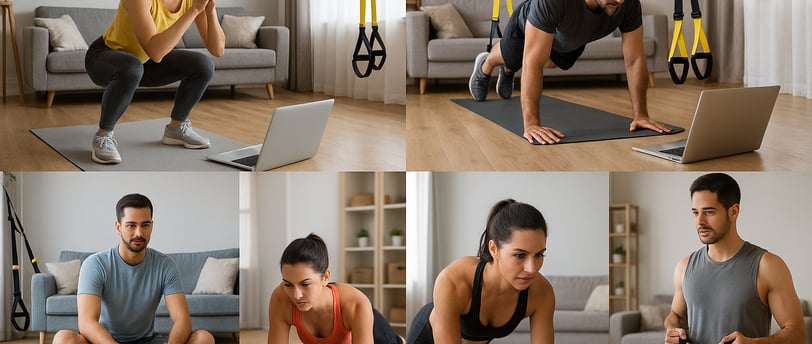TRX vs. Bodyweight: Choosing the Right Home Workout Style for Your Goals
6/18/20252 min read


Introduction to TRX and Bodyweight Training
In the realm of home fitness, two popular workout styles have emerged as frontrunners: TRX training and bodyweight exercises. Both methods have their unique advantages and disadvantages, making them suitable for different fitness goals. This article explores the pros and cons of each method and helps you decide which approach aligns best with your personal objectives, whether they include fat loss, muscle toning, or increased flexibility.
Pros and Cons of TRX Training
TRX training, which utilizes suspension straps, allows for a versatile and full-body workout experience. One significant advantage of TRX is its ability to engage multiple muscle groups simultaneously, promoting overall strength building and functional movement.
Moreover, TRX training can enhance balance and core stability, as many exercises require maintaining body tension while suspended. This is particularly beneficial for athletes and individuals seeking to improve their performance in various sports.
However, the main downside to TRX training is the initial investment in TRX equipment. While the straps are durable and versatile, they do come at a cost. Another consideration is that there is a learning curve involved, as proper form and technique are essential to avoid injury.
Pros and Cons of Bodyweight Training
On the other hand, bodyweight training relies solely on your body as resistance, making it an incredibly accessible workout option. The primary advantage of this method is that it requires no equipment, allowing you to exercise anywhere, anytime. It is an excellent choice for beginners who want to increase strength without the complexities of equipment usage.
Bodyweight exercises also provide a vast array of movements, including push-ups, squats, lunges, and planks, all of which can be modified easily to suit different fitness levels. Furthermore, as you progress, you can enhance difficulty by changing the tempo or adding variations.
However, bodyweight training may pose limitations in terms of progressive overload, especially for individuals accustomed to heavier lifting. As strength increases, finding ways to make bodyweight exercises more challenging can sometimes be difficult.
Making the Decision: Which is Right for You?
When deciding between TRX and bodyweight training, consider your fitness goals. If fat loss is your primary objective, both methods can be effective when paired with proper nutrition. However, TRX may offer additional benefits in terms of strength and functional training, which can enhance overall calorie burn.
For muscle toning, TRX can provide a more structured method to increase resistance by adjusting body angles and leveraging gravity. Conversely, bodyweight training allows for an expansive variety of exercises without the need for equipment.When flexibility improvement is the goal, incorporating both methods may prove beneficial. TRX can facilitate greater range of motion exercises, while bodyweight stretching can enhance mobility.
Ultimately, many individuals find that combining TRX and bodyweight exercises creates a comprehensive home workout routine. Thus, when considering your fitness journey, remember that both styles offer unique benefits and can collectively address various fitness goals.
*IF YOU WANT FOLLOW ALONG FREE WORKOUTS AT HOME PRESS 👉 HERE 👈
